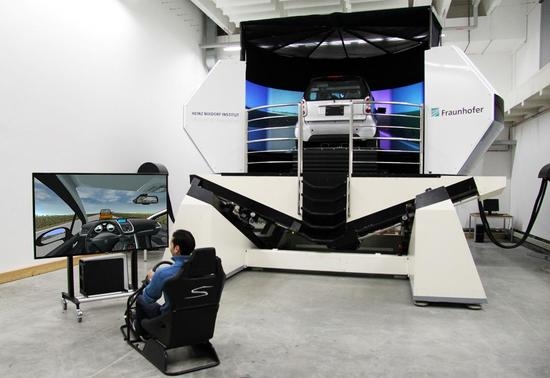Interest Manager for Networked Driving Simulation Based on High-Level Architecture
Abstract
:1. Introduction
2. Problem Description
3. Related Existing Approaches in HLA and Major Drawbacks
4. Development Methodology
4.1. Sending Basic State Simulation Data
4.2. Analyzing Driving Situation
4.3. Generating Notifying Interactions
4.4. Sending and Receiving the Rest of Simulation Data
5. Results and Discussion
5.1. Example Maneuver 1: Two Driving Simulators
5.2. Example Maneuver 2: Four Driving Simulators
6. Conclusions
Acknowledgments
Author Contributions
Conflicts of Interest
References
- Fisher, D.L.; Caird, J.; Rizzo, M.; Lee, J. Application in engineering. In Handbook of Driving Simulation for Engineering, Medicine, and Psychology, 2nd ed.; CRC Press Taylor & Francis Group: Boca Raton, FL, USA, 2011; pp. 33–43. ISBN 978-1-4200-6100-0. [Google Scholar]
- Muehlbacher, D. Multi-driver simulation—The link between driving simulation and traffic simulation. Proceedings of International Scientific Conference on Mobility and Transport Mobil.TUM 2015, Munich, Germany, 30 June–1 July 2015. [Google Scholar]
- Lu, N.; Cheng, N.; Zhang, N.; Shen, X.; Mark, J. Connected vehicles: Solutions and challenges. IEEE Internet. Things. J. 2014, 1, 289–299. [Google Scholar] [CrossRef]
- Kandhai, K.; Smith, M.; Kanneh, A. Immersive driving simulation for driver education and analysis. Proceedings of IEEE 16th International Conference on Computer Games (CGAMES), Louisville, KY, USA, 27–30 July 2011; pp. 288–292, ISBN 978-1-4577-1451-1. [Google Scholar]
- Maag, C.; Muhlbacher, D.; Mark, C.; Kruger, H.P. Studying effects of advanced driver assistance systems (ADAS) on individual and group level using multi-driver simulation. IEEE Intell. Transp. Syst. Mag. 2012, 4, 45–54. [Google Scholar] [CrossRef]
- Oeltze, K.; Schießl, C. Benefits and challenges of multi-driver simulator studies. J. Intell. Transp. Syst. (IET) 2015, 9, 618–625. [Google Scholar] [CrossRef]
- Abdelgawad, K.; Henning, S.; Biemelt, P.; Gausemeier, S.; Trächtler, A. Advanced traffic simulation framework for networked driving simulators. In Proceedings of the 8th IFAC Conference on Advances in Automotive Control (ACC), Kolmården, Sweden, 20–23 June 2016; Volume 49, pp. 101–108. [Google Scholar]
- Wu, Q.; Gu, Y.; Zhu, M.; Rao, N. Optimizing network performance of computing pipelines in distributed environments. In Proceedings of the IEEE International Symposium on Parallel and Distributed Processing (IPDPS), Dublin, Ireland, 14–18 April 2008. [Google Scholar]
- Debroy, S.; Ahmad, M.; Iyengar, M.; Chatterjee, M. Critical sections in networked games. In Proceedings of the 13th IEEE International Conference on Communications (ICC), Budapest, Hungary, 9–13 June 2013. [Google Scholar]
- McLoone, S.; Walsh, P.; Ward, T. An enhanced dead reckoning model for physics-aware multiplayer computer games. In Proceedings of the 16th IEEE/ACM International Symposium on Distributed Simulation and Real Time Applications (DS-RT), Dublin, Ireland, 25–27 October 2012; ISBN 978-1-4673-2954-5. [Google Scholar]
- Quandt, T.; Kröger, S. Introduction: Multiplayer gaming as social media entertainment. In Multiplayer: The Social Aspects of Digital Gaming, 1st ed.; Routledge: Abingdon, UK, 2013; ISBN 978-0415828857. [Google Scholar]
- Awais, M.; Mueller, W.; Elsheikh, A. Using the HLA for distributed continuous simulations. In Proceedings of the 8th Congress on Modeling and Simulation (EUROSIM), Wales, UK, 10–13 September 2013. [Google Scholar]
- Tietje, H. Erfahrungen mit dem Einsatz von DDM. White Paper from the Competence Center Informatik GmbH (CCI); Springer-Verlag: Meppen, Germany, 2001; ISBN 978-3-540-62415-8. [Google Scholar]
- Pan, K.; Turner, S.; Cai, W.; Li, Z. Implementation of data distribution management services in a service oriented HLA RTI. In Proceedings of the Winter Simulation Conference (WSC), Austin, TX, USA, 13–16 December 2009. [Google Scholar]
- Sarbazi-Azad, H.; Zomaya, A. Large Scale Network-Centric Distributed Systems; Wiley-IEEE Computer Society Press: London, UK, 2013; ISBN 978-0-470-93688-7. [Google Scholar]
- Karaoglu, B.; Heinzelman, W. Multicasting vs. broadcasting: What are the Trade-Offs? In Proceedings of the IEEE Conference on Global Telecommunications (GLOBECOM 2010), Miami, FL, USA, 6–10 December 2010; ISBN 978-1-4244-5636-9. [Google Scholar]
- Wang, L.; Turner, S.; Wang, F. Interest management in agent-based distributed simulations. In Proceedings of the 7th IEEE International Symposium on Distributed Simulation and Real-Time Applications, Delft, The Netherlands, 23–25 October 2003. [Google Scholar]
- Ravindran, K.; Mukhopadhyay, S.; Sidhanta, S.; Sabbir, A. Managing shared contexts in distributed multi-player game systems. In Proceedings of the 6th IEEE International Conference on Communication Systems and Networks (COMSNETS), Bangalore, India, 6–10 January 2014; ISBN 978-1-4799-3635-9. [Google Scholar]
- Nouman, A.; Anagnostou, A.; Taylor, S. Developing a distributed agent-based and DES simulation using portico and repast. In Proceedings of the IEEE/ACM 17th International Symposium on Distributed Simulation and Real Time Applications (DS-RT), Delft, The Netherlands, 30 October–1 November 2013. [Google Scholar]
- Wang, S.; Xu, D.; Yan, S. Analysis and application of wireshark in TCP/IP protocol teaching. In Proceedings of the International Conference on E-Health Networking, Digital Ecosystems and Technologies (EDT), Shenzhen, China, 17–18 April 2010. [Google Scholar]








© 2017 by the authors. Licensee MDPI, Basel, Switzerland. This article is an open access article distributed under the terms and conditions of the Creative Commons Attribution (CC BY) license (http://creativecommons.org/licenses/by/4.0/).
Share and Cite
Abdelgawad, K.; Gausemeier, J.; Grafe, M.; Berssenbrügge, J. Interest Manager for Networked Driving Simulation Based on High-Level Architecture. Designs 2017, 1, 3. https://doi.org/10.3390/designs1010003
Abdelgawad K, Gausemeier J, Grafe M, Berssenbrügge J. Interest Manager for Networked Driving Simulation Based on High-Level Architecture. Designs. 2017; 1(1):3. https://doi.org/10.3390/designs1010003
Chicago/Turabian StyleAbdelgawad, Kareem, Jürgen Gausemeier, Michael Grafe, and Jan Berssenbrügge. 2017. "Interest Manager for Networked Driving Simulation Based on High-Level Architecture" Designs 1, no. 1: 3. https://doi.org/10.3390/designs1010003
APA StyleAbdelgawad, K., Gausemeier, J., Grafe, M., & Berssenbrügge, J. (2017). Interest Manager for Networked Driving Simulation Based on High-Level Architecture. Designs, 1(1), 3. https://doi.org/10.3390/designs1010003






